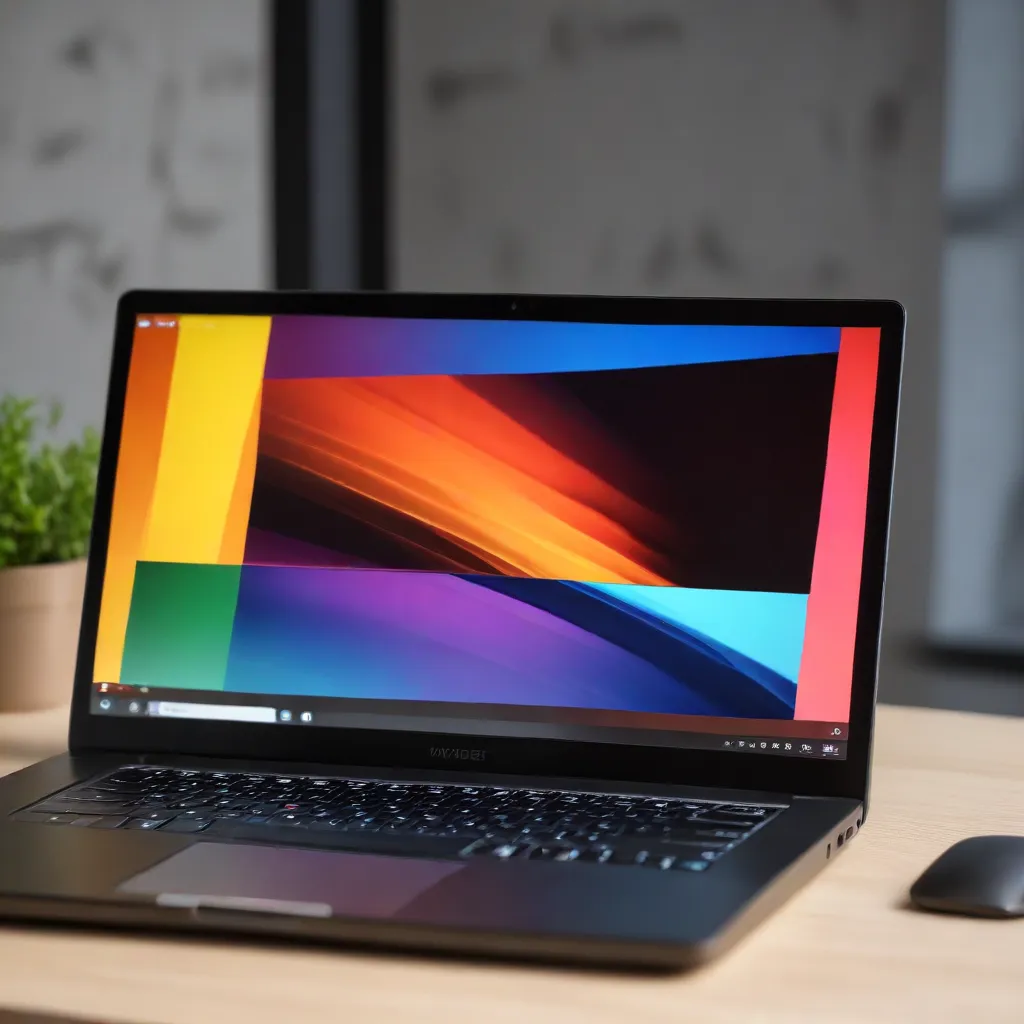
Understanding the Importance of Color Calibration
As a seasoned IT professional, I know the critical role that accurate color representation plays in various digital tasks, from graphic design and photo editing to online shopping and video production. Proper monitor calibration is essential for ensuring that the colors you see on your laptop screen accurately match the original digital content, whether it’s an image, a product listing, or a video frame.
Without calibration, the default settings of your laptop display may fail to reproduce colors faithfully, leading to inconsistent and inaccurate visuals. This can be especially problematic for professionals who rely on color-sensitive work, as it can result in significant discrepancies between what they see on the screen and the final output.
Calibrating your laptop display is akin to wearing the perfect pair of glasses – it brings the world to life, allowing you to see the true colors in all their glory.
The Benefits of Laptop Screen Calibration
Calibrating your laptop screen offers numerous advantages that go beyond just enhancing color accuracy. Here are some of the key benefits:
-
Consistent Visuals Across Devices: By calibrating your laptop screen, you can ensure that the colors you see are consistent across different devices, applications, and platforms. This is particularly important for professionals who work on projects that require a cohesive visual identity.
-
Improved Online Shopping Experience: For online shoppers, accurate color representation is crucial when selecting products. Calibrating your laptop screen can minimize the risk of disappointment due to color variations between what you see on the screen and the actual product you receive.
-
Enhanced Creativity and Precision: Whether you’re a photographer editing your masterpieces or an artist creating digital illustrations, precise color reproduction is essential for expressing your creativity and achieving the desired results. Calibrated laptop screens ensure that your work looks as intended.
-
Reduced Eye Strain: Calibrating your laptop screen to optimal brightness and contrast settings can help reduce eye strain, making long hours of screen time more comfortable and less fatiguing.
-
Accurate On-Screen Measurements: In tasks where precise measurements are crucial, such as architectural or engineering software, calibrating your laptop screen ensures that the dimensions and colors you see on-screen align closely with real-world measurements, facilitating more accurate and reliable work.
Step-by-Step Guide to Calibrating Your Laptop Screen
Fortunately, calibrating your laptop screen is a straightforward process that can be done using the built-in tools provided by your operating system. Here’s a step-by-step guide to help you achieve accurate color representation on your laptop:
Windows 11 Calibration
- Open the Start menu and search for “Color Management”.
- In the Color Management window, click on the “Calibrate display” button.
- Follow the on-screen instructions to adjust the gamma, brightness, contrast, and color balance settings of your laptop screen.
- Once the calibration process is complete, your laptop screen will be optimized for accurate color representation.
Windows 10 Calibration
- Open the Start menu and search for “Color Management”.
- In the Color Management window, click on the “Calibrate display” button.
- Follow the on-screen instructions to adjust the gamma, brightness, contrast, and color balance settings of your laptop screen.
- Once the calibration process is complete, your laptop screen will be optimized for accurate color representation.
It’s important to note that the calibration process may vary slightly depending on your laptop model and the specific display settings available. Additionally, it’s recommended to ensure that your laptop screen has been turned on for at least 30 minutes before calibrating to allow it to reach its normal brightness and color levels.
Tips for Achieving Optimal Color Accuracy
To further enhance the color accuracy of your laptop screen, consider the following tips:
-
Ambient Lighting Conditions: Calibrate your laptop screen in the lighting conditions you typically work in. If the ambient light changes frequently, consider a monitor with ambient light sensors that can adjust settings dynamically.
-
Hardware Calibration: For tasks that require the highest level of color accuracy, such as graphic design or photography, consider investing in a dedicated colorimeter. This hardware-based calibration method provides more precise adjustments compared to software-based calibration.
-
Monitor Selection: When purchasing a new laptop, research the display specifications and choose a model with a wider color gamut, higher color accuracy, and support for industry-standard color spaces like sRGB or Adobe RGB.
-
Consistent Calibration: Regularly calibrate your laptop screen, especially if you work with color-sensitive content. The frequency of calibration will depend on the importance of color accuracy in your work, but a monthly or quarterly schedule is generally recommended.
-
Maintain Optimal Settings: Avoid extreme brightness or contrast settings, as they can negatively impact color accuracy and potentially shorten the lifespan of your laptop display.
By following these tips and regularly calibrating your laptop screen, you can ensure that the colors you see on your screen accurately represent the digital content you’re working with, leading to more reliable and satisfying visual experiences.
Conclusion
Calibrating your laptop display is a crucial step in achieving accurate color representation, whether you’re a professional in a color-sensitive field or a casual user who wants to enjoy a more vibrant and true-to-life visual experience. By leveraging the built-in calibration tools provided by your operating system and incorporating additional tips, you can transform your laptop screen into a precise, color-accurate display that enhances your digital work and leisure activities.
Remember, color calibration is not just about aesthetics – it’s a vital component in ensuring the consistency, accuracy, and reliability of your digital content. By investing the time and effort to calibrate your laptop screen, you’ll unlock a world of enhanced visual experiences and unlock new possibilities in your work and personal life.
For more expert insights and practical tips on IT solutions, computer repair, and technology trends, be sure to explore the ITFix blog regularly.












